A product description is copy that tells customers about the features of an offering. Its purpose is to help buyers understand why they should purchase the product. Effective descriptions generate sales by explaining the product’s unique value proposition as well as how it solves a frustrating problem.
Why are product descriptions important?
The buyer’s decision-making process initiates long before he or she arrives at your product pages. Whether you’re selling consumer products or business services, your target customer has likely encountered a problem and is looking for a solution.
A weak product description can be the Achilles heel of a marketing campaign.
Marketing assets like traditional advertisements, social media campaigns, blogs and videos generate awareness of your brand and drive readers to your ecommerce website or store. At that point, your product descriptions take over and perform the heavy lifting. It’s the product description’s job to get the buyer over the last hurdle.
A weak product description can be the Achilles heel of a marketing campaign. All of the other assets can work perfectly, but an uninformative product description can derail everything at the last minute. In fact, 98% of shoppers have stopped mid-way through a purchase because content on the page was incomplete or inaccurate.
Your marketing campaigns should increase interest in your offerings, while your product descriptions reinforce trust in your brand. Missing information, spelling errors, bad product photography and similar blunders can quickly erode trust in your brand. On the other hand, polished product descriptions make your company look legitimate and professional. You need that trust to make sales.
How service descriptions support B2B marketing
Marketers who are in the business of selling intangible services face a unique challenge. How do you describe something that has no physical form? What type of imagery do you use to showcase a service with little to no observable features?
Service descriptions can be more challenging to write, but they follow a pattern similar to descriptions of products. Namely, their purpose is to help buyers make a final decision.
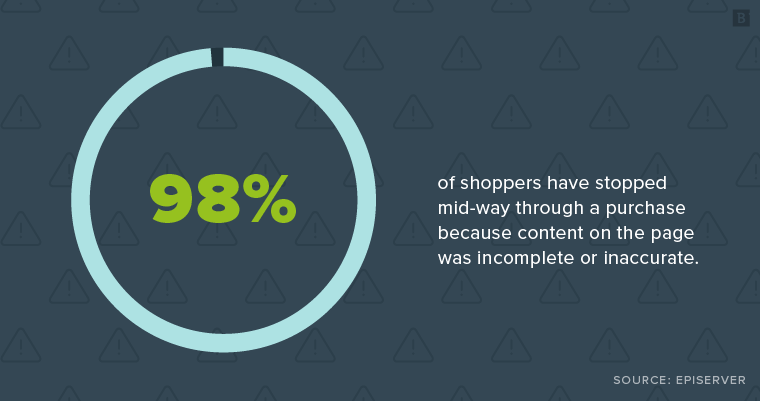
If your organization has a sales team, there’s a good chance you already have everything you need to craft effective service descriptions. It’s best practice to align your descriptions with your sales pitch. This creates consistency for your buyers and ensures your sales team isn’t thrown off guard by an unfamiliar claim.
Service descriptions help to convert customers by showing them the solution to a challenge. For example, if buyers are looking for accounting services, they may want to know things like what types of reports the firm can produce, how frequently they will be available for consulting, etc.
Many of the best practices described below will apply to service descriptions. Always keep in mind the customer’s goals when describing the products or services you provide.
11 product description best practices that increase sales engagement
Effective product descriptions not only give customers information about the offering but also deliver psychological appeals. According to Harvard Business School professor Gerald Zaltsman, 95% of purchase decisions take place in the subconscious mind.
As you write product descriptions, pay close attention to the types of words and phrases you use. Action verbs and active phrasing are key to driving buyer behaviors. In addition, you’ll want to write unique descriptions for each of your products to avoid getting penalized for duplicate content on your site.
95% of purchase decisions take place in the subconscious mind.
Measure your descriptions against these 11 best practices to ensure they lead to the results you’re looking for:
1. Write with your ideal buyer in mind
To write a persuasive product description, you must understand your target audience. Refer to your buyer personas as you develop the marketing copy that will go on your product and service pages. This will help you understand which features and benefits appeal to the people who are most likely to buy from you.
Ask yourself these questions about your customers as you develop your descriptions:
- How will our customers find this product page?
- What problem are they trying to solve?
- What do they already know about our product?
- What benefits and features will they find most interesting?
As Seth Godin explained, one of the main goals of your marketing efforts is to help your loyal customers learn how to talk about your products with their friends and acquaintances. How can your product descriptions help them to spread the word about your offering?
Example: KitchenAid
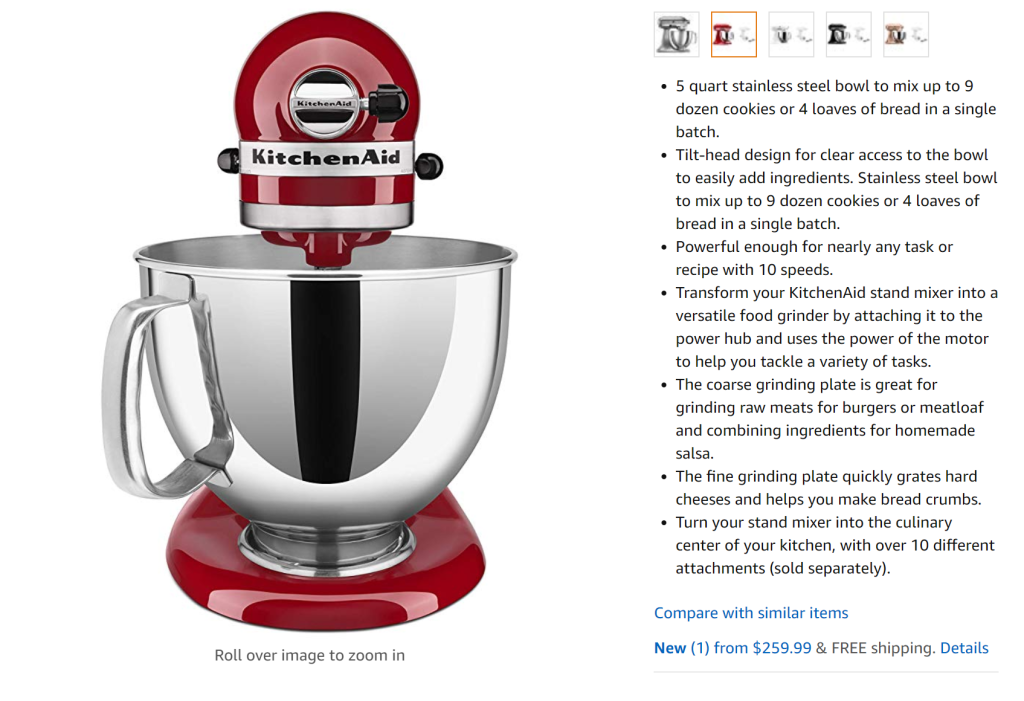
KitchenAid demonstrates its understanding of buyer challenges by highlighting key benefits in the description of its stand mixer. Several of the bullet points describe use cases that the reader will easily relate with.
2. Avoid obvious statements
An effective product description should certainly contain a description of your product – but try to avoid the obvious. If you sell shoes, for example, you probably don’t need to explain that your products are garments designed to protect the customer’s feet from the ground.
We call these “water is wet” statements. They’re obvious facts that the reader should understand intuitively. If someone reading your product descriptions doesn’t understand these essentials, they probably aren’t yet ready to buy. You can use other types of marketing content like blogs and infographics to get them up to speed before they return to your product pages.
Example: Police Dog Pet Costume
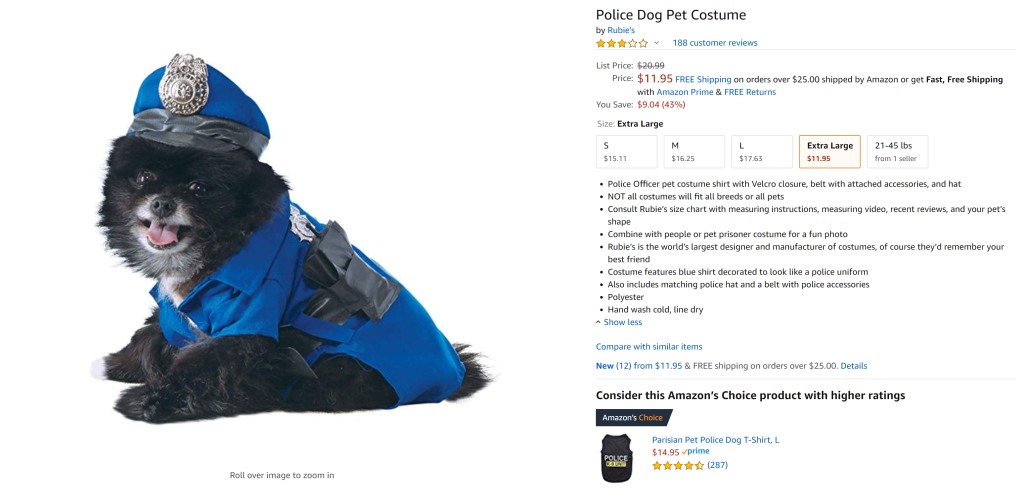
This description for a police costume for a dog describes the costume as resembling a police uniform. It’s a bit redundant, don’t you think?
3. Be careful with superlatives
If your product is the easiest, the most advanced or the best in the world, then by all means tell your customers about it. But make sure you can back up your claims. If your claims are overly bold, skeptical readers will likely roll their eyes and walk away.
You could walk from Manhattan to Brooklyn and see half a dozen or more pizza shops that claim to offer the best pies in the city. Some even claim to be world famous. Not only are these types of statements unverifiable, but they’re also easy to refute. Ask anyone in Iowa City if they’ve ever heard of Di Fara Pizzeria and you’re likely to get more blank stares than salivating mouths.
If you’re going to claim to be the best, the most intuitive, the most affordable or any other superlative, make sure you have the data to back up your claim.
Example: Titleist
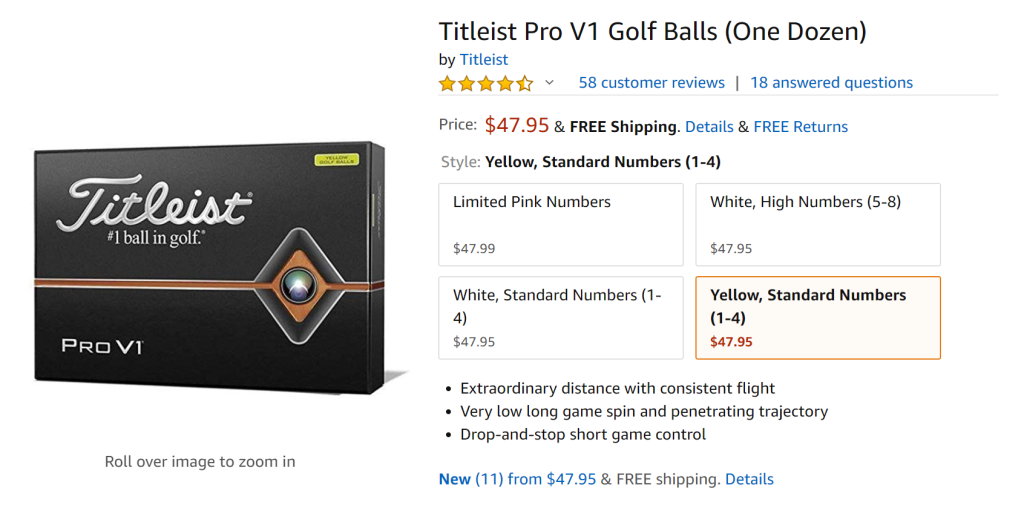
This product may be simple, but Titleist knows it’s speaking to dedicated golfers, not just casual enthusiasts. Its description uses strong, evocative language because it’s claiming to be the best on the market.
4. Appeal to your buyer’s senses
Creative writing helps buyers to imagine themselves using the product before they make a decision to buy. Evoke the five senses in your writing to spur these leaps of imagination. Expressive language elevates your product descriptions from bland characterizations to enticing depictions.
For example, clothiers selling to the fashionable crowd may describe how their outfits hang comfortably from the wearer’s frame. A maker of handcrafted fountain pens might describe how smoothly the nib distributes ink across the paper.
Spend some time using your product and make notes about the sensations you experience. How does the product make you feel? Which of your senses are involved in the experience? Work these impressions into your copy.
Example: David’s Tea
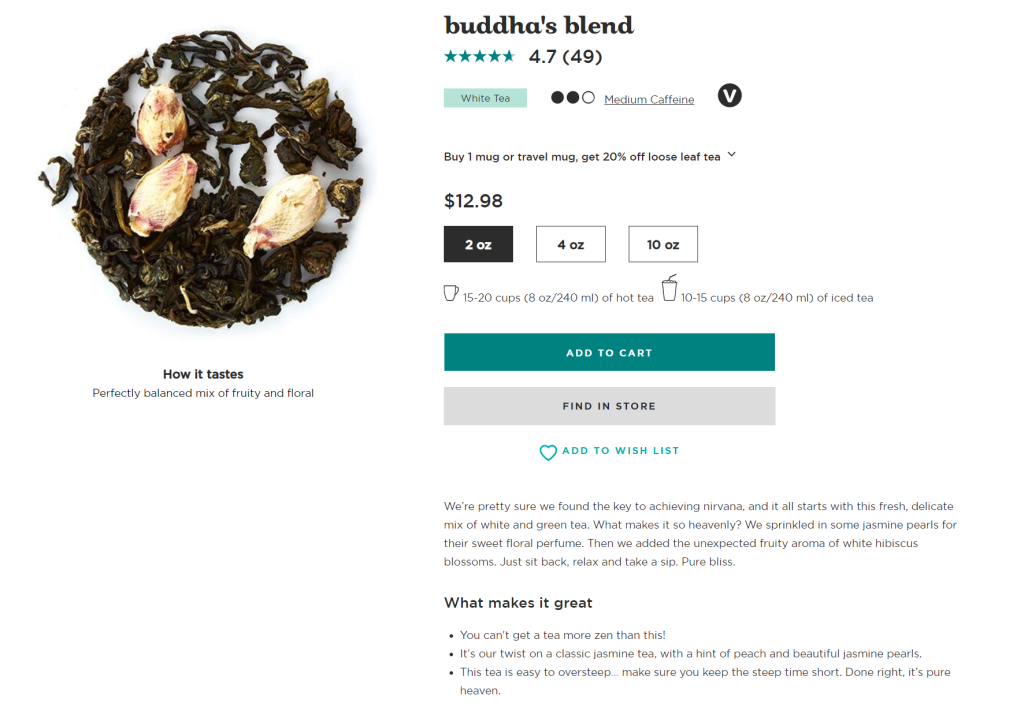
In a photo, dried tea leaves don’t look like much. David’s Tea uses product descriptions that prompt readers to imagine themselves taking a sip and inhaling the delicious aroma.
5. Tell your brand story
Every piece of marketing collateral you produce has a place within your brand story, and your product descriptions are no exception. Like any good story, the narrative of your brand should evoke an emotion in your customers.
Within your product descriptions, your brand story will likely relate to the overcoming of a challenge. As customers near the point in their journey when they’re ready to make a purchase, they’re likely anticipating how the product will make a change in their life. Your marketing copy should confirm that feeling and add to it.
Remember, you are not always the author of your brand story. Your customers are just as responsible for the direction your business takes. Find ways to include the customer in that journey and you’ll have a strong product description.
Example: Red Wing Shoes
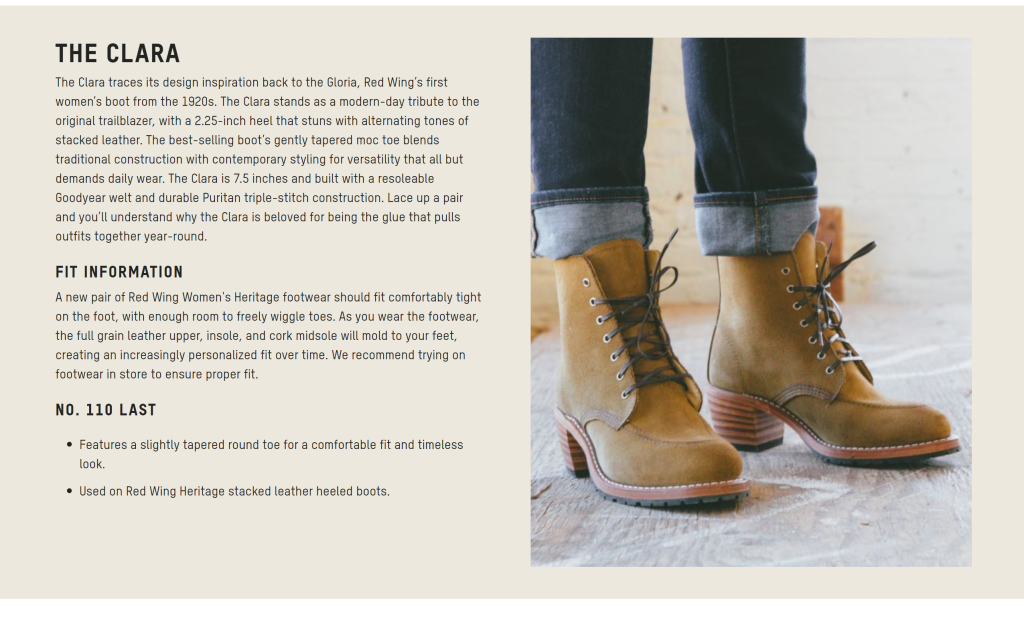
Red Wing Shoes has been around since 1905, and the brand injects all of its marketing with those decades of experience. This product description calls on the craftsmanship of a bygone era to describe this modern product.
6. Align your descriptions with other marketing efforts
Product description writers shouldn’t work in a bubble. In fact, everyone working in marketing and sales should be on the same page when describing product benefits.
Look through your recent marketing campaigns and pull out the appeals that have worked well. Your product descriptions should confirm the findings laid out in your blogs and conform with the data you present in your infographics.
Customers will likely encounter your brand several times before they decide to purchase. If they see discrepancies between your ad campaigns, they may think twice about handing over their hard-earned cash.
Example: Squarespace


Squarespace aligns its traditional advertising messages with the copy found on its product pages. In the ad example, Squarespace claims that its websites can help businesses stand out in the marketplace. In the description example, the brand extends the claim by showing how its SEO tools increase brand awareness.
7. Provide social proof
When customers see how other buyers have benefitted from a product or service, they’re more likely to make a purchase. Including social proof such as testimonials and case studies in your product descriptions can nudge customers in the right direction.
For example, you could include customer snapshots of their purchased products in addition to your polished imagery. This can help potential buyers to imagine themselves using your product. In addition, some customers will always take marketing copy with a grain of salt. Social proof helps these customers see how your offerings perform in the real world.
Example: The Bullet Journal Method by Ryder Carroll
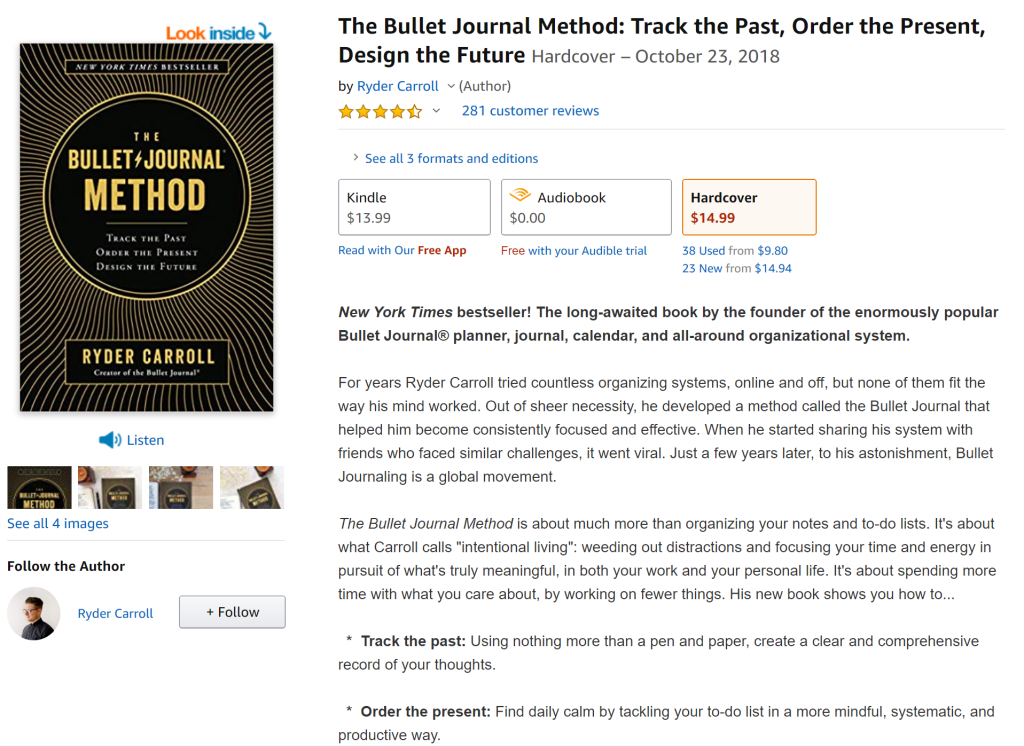
This example follows a tried-and-true method of social proof that book sellers have leveraged for decades. Above the description, in bold text are those coveted words: “New York Times bestseller.” Clearly, many people have already benefited from the advice within the book.
8. Optimize your text for readability
The length of your product description will depend on the offering and the assumed level of knowledge possessed by your target audience. Whether you need just a few sentences or a couple of paragraphs, you should ensure your descriptions are scannable.
Use bullet points, short paragraphs and bolded words to help potential buyers find the information they need immediately. If you need to go into detail about several aspects of your product, then consider writing a brief summary followed by more detailed paragraphs.
Example: GreenWorks
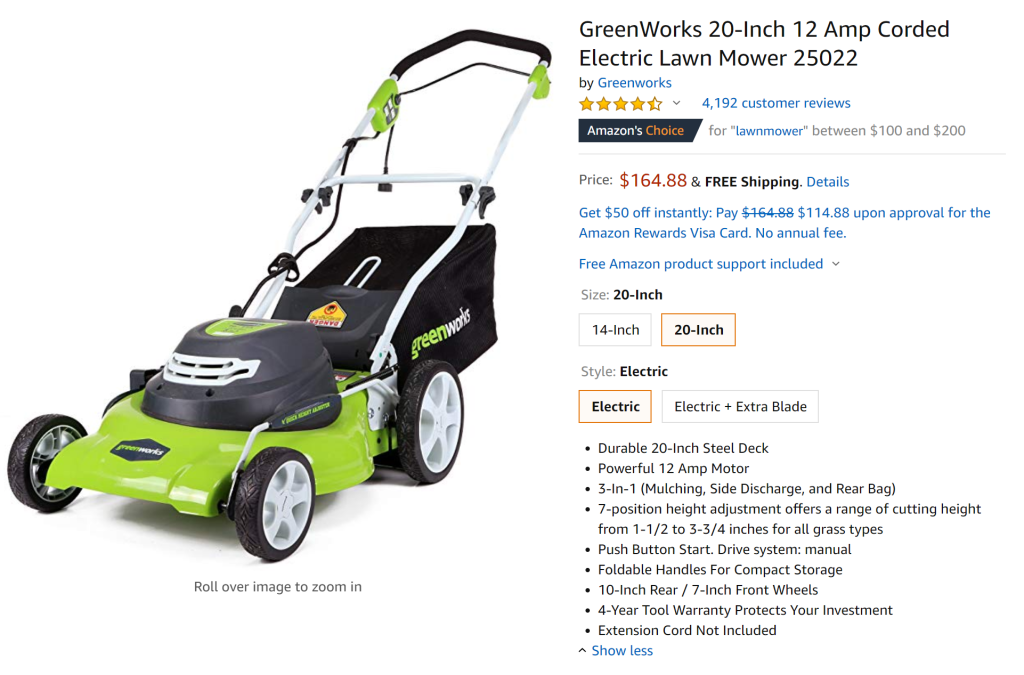
It’s just the facts in this scannable product description. Potential buyers are probably comparing several different mowers based on price point and features. This description clearly lays out the most important details to help customers make their purchase decision.
9. Don’t forget about SEO
Written product descriptions have two audiences: humans who will buy your products and search algorithms that will help humans find your product pages. Placing keywords in your product descriptions can help them to rank higher on search engine results pages (SERPs), as well as site-specific search results, such as on the Amazon marketplace.
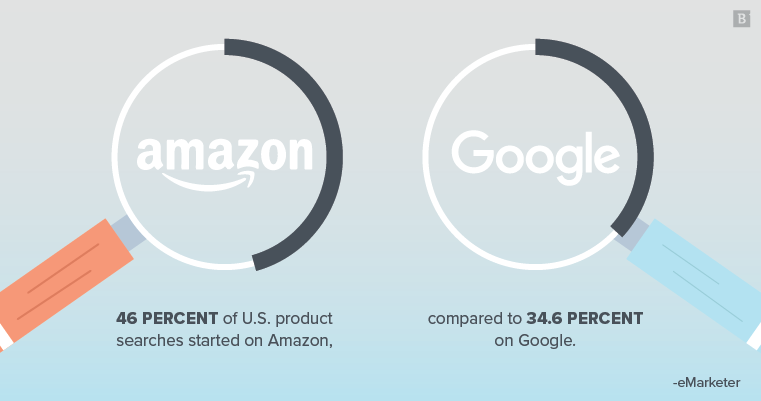
Try to include one keyword in your product titles and one or two more in your bullet points. Think about the search queries that users might use to find your product and use similar language.
Check out our complete Amazon SEO guide to learn more.
Example: Bose
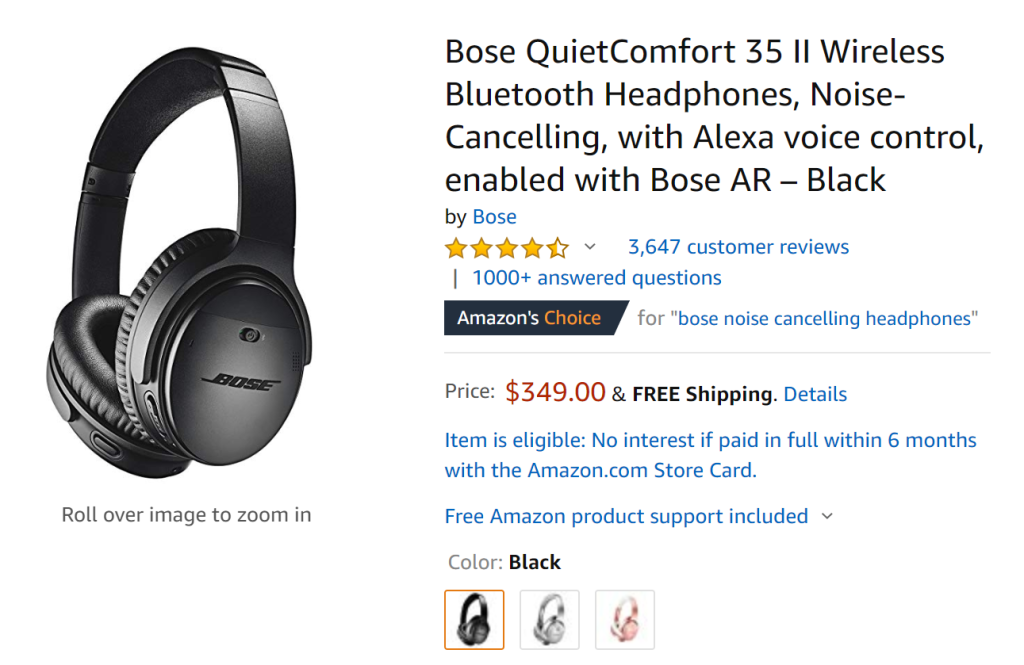
The product title for these headphones contains several keywords that potential buyers might search on Amazon. This way, a single description can capture buyers looking for Bluetooth-enabled products, noise-cancelling devices or headphones equipped with digital assistants.
10. Use a mix of media
Effective product descriptions are accompanied by enticing imagery. Use high-definition pictures and videos to support the claims made in your copy. For instance, if you can claim that your product makes a process more efficient, show this advantage in action.
For many shoppers, seeing is believing. The more concrete proof you can provide to support your claims, the better. This is also a great opportunity to repurpose some of your other marketing materials. For instance, if you have recorded a product demonstration, cut it up into short clips or gifs to display on your product page.
Example: Milk Bar
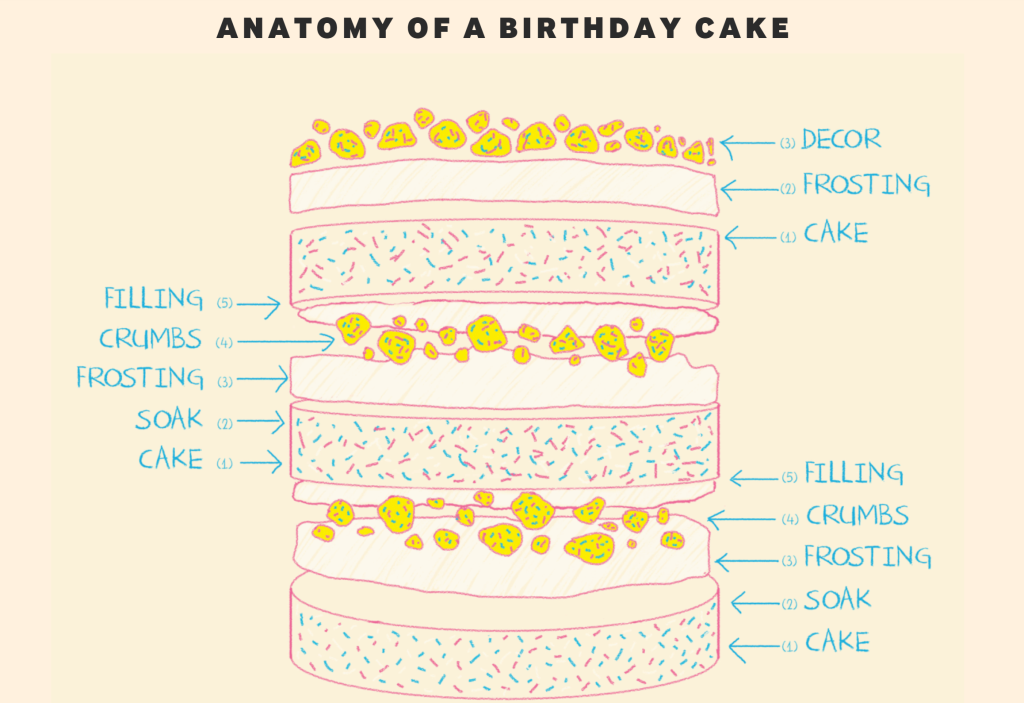

Milk Bar uses a combination of photography, high-definition gifs, illustrations and text to describe its birthday cake offering. Each piece works in tandem to appeal to the reader’s senses as well as their need for a quality product. Potential buyers have everything they need to make a decision.
11. Conduct split tests
Even the best marketing writers don’t create perfect copy the first time around. There is simply too much to know about your target audience. No matter how much prior research you conduct, you’ll likely miss something important.
So what happens when you have two or more great ideas, but you don’t know which will drive the most sales? That’s where split testing comes in. Using a tool like Google Optimize or enterprise email marketing platforms, you can test multiple versions of your copy and measure the results of each to determine which is best.
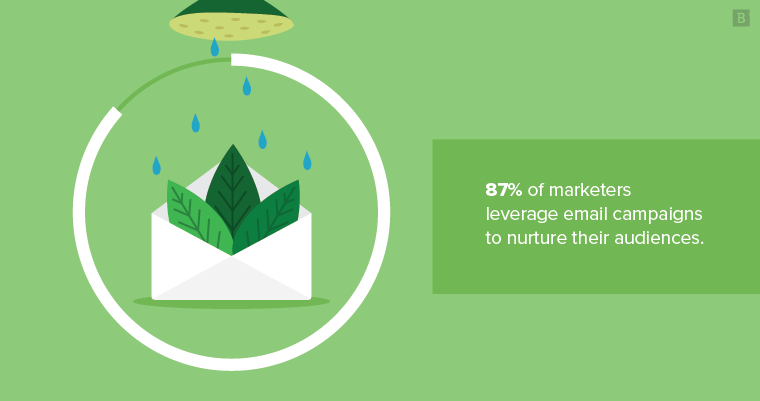
You might find that a certain turn of phrase leads to more conversions than another. But you won’t know until you test them both.
Repurposing descriptions as marketing collateral
Product descriptions should fit nicely into your content repurposing workflow. If you follow the best practices above, each of your descriptions will be a highly optimized summary of everything customers want to know about your offerings.
The next time you’re stuck for an appeal when creating new content, you can turn to your product descriptions for inspiration. In addition, the alignment between your product pages and content marketing will help steer potential buyers in the right direction.
By repurposing your product descriptions, you can extend the reach of your content and ensure that new buyers are exposed to your products’ features and benefits.





